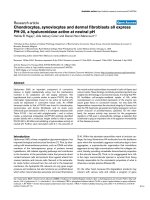222. More Organic Foods at Wal-Mart Stores pps
Bạn đang xem bản rút gọn của tài liệu. Xem và tải ngay bản đầy đủ của tài liệu tại đây (70.05 KB, 2 trang )
More Organic Foods at Wal-Mart Stores
Written by Mario Ritter
22 May 2006
I’m Shep O'Neal with the VOA Special English Agriculture Report.
Sales of organic foods in the United States have been growing since the nineteen seventies. The
Organic Trade Association says sales last year reached almost fourteen thousand million dollars. Yet
that was only two and one-half percent of all food sales.
But now there is a sign that organics have risen to a new level of economic importance. This spring,
Wal-Mart announced an effort to double the number of organic products in its stores.
Stores like Whole Foods and Trader Joe’s have sold organic products for years. But in recent years
organic sales have grown sharply. Products like organic milk and eggs have appeared in most grocery
stores.
Wal-Mart sells thousands of products, including food. Many of its stores contain markets. Wal-Mart
says it wants to offer greater choice to more people.
But critics say the actions of such a huge seller could put pressure on organic producers. They say it
will be harder to know if producers are following the rules for organics as larger companies push
demand higher.
At the same time, Wal-Mart's efforts are expected to push prices lower. A Wal-Mart official
reportedly said his company plans to sell organics at only ten percent over the price of non-organic
versions.
Some people have been willing to pay five or ten times that. They believe organic foods are healthier
and safer. Others dispute this, and some say it can depend on the products.
Organic products may not be genetically engineered. They must be made only with natural processes
and materials. Crops must be raised without most of the chemicals that farmers use now. Animals
cannot be given antibiotics or other drugs to increase growth. And they must be fed organically
grown food.
Yet the food industry uses many different marketing terms. Claims like "all-natural" can mean
different things. But a product must contain at least ninety-five percent organic materials to be called
organic.
Some people worry that the rules for organic foods will be weakened as big companies expand into
the market.
The National Organic Program of the United States Department of Agriculture sets those rules. Farms
must give a production plan to a certifying agent approved by the department. If the agent approves
the plan, only then can the U.S.D.A. Organic Seal appear on their products.
This VOA Special English Agriculture Report was written by Mario Ritter. Read and listen to our reports at
voaspecialenglish.com. I'm Shep O'Neal.









